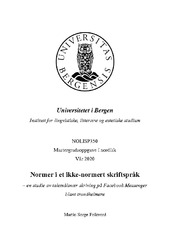| dc.contributor.author | Folkvord, Martin Sorge | |
| dc.date.accessioned | 2020-06-24T05:35:06Z | |
| dc.date.available | 2020-06-24T05:35:06Z | |
| dc.date.issued | 2020-06-20 | |
| dc.date.submitted | 2020-06-19T22:00:07Z | |
| dc.identifier.uri | https://hdl.handle.net/1956/22890 | |
| dc.description.abstract | Denne oppgaven tar for seg talemålsnær skriving i chat-samtalene til åtte trondheimere mellom 21 og 26 år. Det teoretiske rammeverket i oppgaven består i stor grad av etablerte sosiolingvistiske kunnskaper om muntlig kommunikasjon. Dette inkluderer blant annet teori om forholdet mellom språk og identitet, hvorav særlig ulike dimensjoner av begrepet autentisitet er vesentlig for tolkningene jeg gjør. Videre spiller også teori om nettverkstetthet- og kompleksitet en sentral rolle for hvordan den talemålsnære skrivinga forstås i avhandlingen. I tillegg til teori som overføres direkte fra den muntlige til den skriftlige modaliteten, blir noe teori tilpasset for å fungere i en skriftspråklig kontekst. Her er særlig begrepet standardnormsaliens viktig, som brukes om bevisstheten hos en språkbruker om at en skriftlig standardform ikke gjenspeiler hennes uttale av et gitt ord. I utdragene fra de 96 ulike Facebook Messenger-samtalene som utgjør datamaterialet i studien, kommer det frem at alle informantene skriver talemålsnært i utstrakt grad. Det er også tydelig at det eksisterer internaliserte normer hos informantene for hvordan de skal skrive talemålsnært, selv om de ikke er seg bevisste disse normene. Analysene viser at normene bygger på et bokmålsfundament, men at enkelte sentrale ord (blant annet flere pronomen i førstepersons entall, ulike verbformer og spørreord) bryter med skrivemåten i standardnormen og får en mer talemålsnær realisering. Hvilke ord dette gjelder, kan muligens henge sammen med graden av standardnormsaliens informantene oppfatter at et gitt ord har, men dette er en hypotese det trengs videre studier for å styrke. Studien viser at den talemålsnære skrivinga må ses som en egen skriftnorm som avviker fra både bokmål og transkribert tale. Det er også tydelig at chat og andre kommunikasjonsplattformer med lignende egenskaper har vært en forutsetning for at det har oppstått normer for denne måten å skrive på. Videre forskning bør følge hvordan talemålsnær skriving blir tradert når nye generasjoner får tilgang på denne teknologien i enda yngre alder, og de lærer å skrive både standardnormert og talemålsnært samtidig. | en_US |
| dc.description.abstract | This thesis examines vernacular approximated writing in chat conversations of eight persons, aged between 21 and 26, all from the city of Trondheim, Norway. The theoretical framework of the thesis mainly consists of sociolinguistic theories developed for oral communication. This includes theories about the relation between speech and identity, of which particularly the term authenticity is key to the interpretations I make. Theories about network density and complexity are also integral to how vernacular approximated writing is understood in this thesis. In addition to such theories that are applied directly from spoken to written language, some theories are adapted to be applicable in the context of chat communication. Of these, the term standard norm salience is particularly significant, which is used to describe the awareness of a writer that her vernacular pronunciation is not reflected in the standardized spelling of a word. In the excerpts from the 96 different Messenger conversations that make up the data material, it is evident that all participants write vernacular approximated to a large extent. Furthermore, it is clear that the participants adhere to internalized norms that regulate how they convey their vernacular in writing, despite not being consciously aware of it themselves. These norms build on the framework of the standardized Norwegian bokmål, but with several key words written in a manner that represent the participants’ dialectal features. Such key words include first person singular pronouns, several tenses of verbs and interrogative words. Which words are differentiated from the standardization and which are not, may be connected to the degree of standard norm salience the participants perceive in a word. However, more research is required on this matter to say so with more certainty. The study shows that vernacular approximated writing has to be regarded as an independent written norm that deviates from both written Norwgian bokmål and transcribed speech. It is also evident that computer mediated communication has been a necessary precondition for the forming of the internalized norms for vernacular approximated writing that the participants in this study adhere to. Further research should focus on what shape these norms take when future generations gain access to this technology at an even younger age, which potentially could lead to standardized Norwegian and vernacular approximated writing being learned at the same time. | en_US |
| dc.language.iso | nob | |
| dc.publisher | The University of Bergen | |
| dc.rights | Copyright the Author. All rights reserved | |
| dc.subject | sosiale medier | |
| dc.subject | sosiolingvistikk | |
| dc.subject | dialektskriving | |
| dc.subject | språknormer | |
| dc.subject | skriftspråk | |
| dc.subject | Messenger | |
| dc.subject | Trondheim | |
| dc.subject | talemålsnær skriving | |
| dc.subject | Facebook | |
| dc.title | Normer i et ikke-normert skriftspråk – en studie av talemålsnær skriving på Facebook Messenger blant trondheimere | |
| dc.title.alternative | Norms in a normless written language – a study of vernacular approximated writing on Facebook Messenger | |
| dc.type | Master thesis | |
| dc.date.updated | 2020-06-19T22:00:07Z | |
| dc.rights.holder | Copyright the Author. All rights reserved | |
| dc.description.degree | Mastergradsoppgave i nordisk språk og litteratur | |
| dc.description.localcode | MAHF-NORD | |
| dc.description.localcode | MAHF-LÆNO | |
| dc.description.localcode | NOLISP350 | |
| dc.subject.nus | 711123 | |
| fs.subjectcode | NOLISP350 | |
| fs.unitcode | 11-21-0 | |
